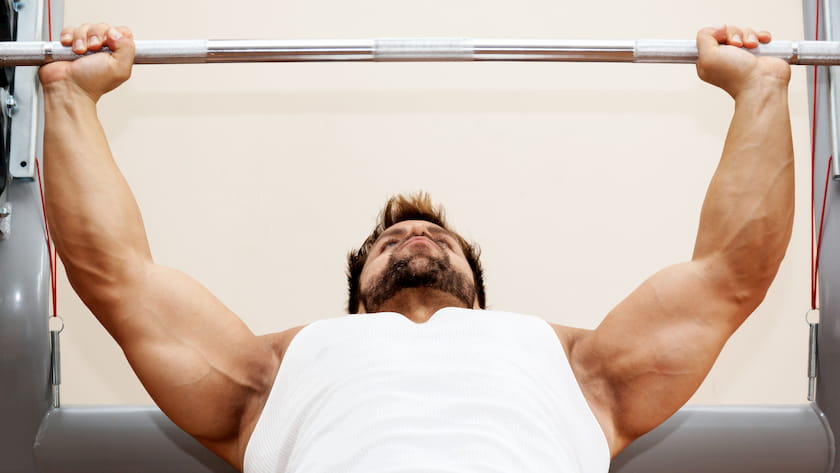Free Weights or Machines?
This is a topic that has divided the world of training since Nautilus first introduced their new-fangled machines to the world of exercises.
There are those proponents who think, ‘Free weights don’t maximize your gains, man!’. While there are those who choose the ‘If it’s not on a bar, I’m not going to lift it’ approach to training.
But, who is right? What does the science say?
In this article, we’re going to weigh in on the argument to help you, our loyal lifters, make the most of your workouts.
What’s all the fuss about?
If you talk to any trainer, in any gym, on any day of the week, they’re going to take a divided stance on this point.
There are the ‘functional’ trainers, who believe all machines (that aren’t on a pivoting cable) are the devil. Whereas there are the most traditional bodybuilding trainers, who swear their life by them.
And, there is everyone else who sits at some point between on that spectrum. Which is probably where you are plotted somewhere.
This argument is making a lot of noise in the industry, even more so as of late, so we want to give you a solid, scientific approach, away from the rest of the Internet ‘Bros’.
So, what are we looking at, and why?
Free Weights: Making The Most Of The Movement
Completing free weight exercises does two things:
- Requires more from your body to perform the movement
- Uses more of the muscle to do it [1]
So, the argument on this side of the coin is that Free Weights are the best possible option to make the most of your workout. And, to an extent, they’re not wrong.
You use up to 50% more calories by completing free weight exercises [2], while activating more of the overall muscle. This allows you to
- Maximize your time
- Increases testosterone levels [3]
- Burn more fat
- Increase overall strength
Which goes to show that free-weights provide a lot of benefits, with few drawbacks. They help make you stronger, build bigger muscles, put on lean muscle mass, and get leaner.
This happens because your body has to stabilize more to do the movement.
This is because, well, there is a whole lot of difference in having a 200lbs Olympic bar on your back than a 200lbs leg press underneath you. Your body has to work a whole lot harder to deal with that level of stress. Not to mention the effect it has on your core [1].
So, if free-weights provide the most bang for your buck – what do machines have to offer?
Machine Weights: Making The Most Of The Muscle
Machine weights are the targeted approach to training. They’re designed to make the most of that particular muscle and increase the training load there specifically.
For example, a squat might do the most overall for your legs. But, a leg extension will have a greater effect on your rectus femoris (The ‘big’ bit of your quads).
They also remove the effects on stabilizer muscles, by withdrawing them from the movement altogether. The muscles surrounding the ‘target’ muscles aren’t required to aid in the movement, so they do less.
This has a couple of benefits:
- It’s easier to overload a particular muscle
- You can train longer on one specific muscle group
- You can get just as strong in that movement by training machine weights, as you can training with free weights. [4]
- Increased safety on drop-sets.
And, these are benefits you’re going to want for certain goals.
Which brings us perfectly around to our verdict.
Most Effective Training Method
So, which training method do we think is most effective?
Well, that gives us the opportunity to give you the most common (and honest) answer in the whole of fitness.
It depends.
It depends on your training goal. It depends on how long you’ve been training. It depends on what you’re looking to achieve. Your injuries and your overall training history. There is no ‘cookie cutter’ approach to training, so it’s all down to you.
The science shows benefits to both sides of the argument.
But, the argument strongly favors Free Weight training. And, we see more carry-over benefits to the rest of your life than using machines.
Our honest advice?
Focus 80% of your training on the all-important free weight exercises. Then, spend the other 20% working on your problem areas by using machines.
What do you think? Which side are you one: free weights or machines?
More Reading: Beginner Training Programs
References:
[1] Gottschall, J.S., Mills, J., Hastings, B. Integration Core Exercises Elicit Greater Muscle Activation Than Isolation Exercises. Journal of Strength and Conditioning Research, 27, 3, 590-596.
[2] Physiologic and Metabolic Responses to a Continuous Functional Resistance Exercise Workout – Lagally, Kristen M; Cordero, Jeanine; Good, Jon; Brown, Dale D; McCaw, Steven T
[3] Hormonal Responses to Different Resistance Exercise Schemes of Similar Total Volume – Uchida, Marco C1,2; Crewther, Blair T3; Ugrinowitsch, Carlos4; Bacurau, Reury Frank P5; Moriscot, Anselmo S1; Aoki, Marcelo S5
[4] A Comparison of Muscle Activation Between a Smith Machine and Free Weight Bench Press – Schick, Evan E; Coburn, Jared W; Brown, Lee E; Judelson, Daniel A; Khamoui, Andy V; Tran, Tai T; Uribe, Brandon P
Popular Guides:
How to Build Muscle Naturally – Training, Diet, and Supplementation
How to Build Lean Muscle Mass Fast – The Ultimate Bulking Guide
Pre-Workout Supplements Guide – What Are The Best Pre-Workout Supplements?
Post-Workout Supplements Guide – What Post-Workout Supplements Work Best?




Leave a comment
All comments are moderated before being published.
This site is protected by hCaptcha and the hCaptcha Privacy Policy and Terms of Service apply.